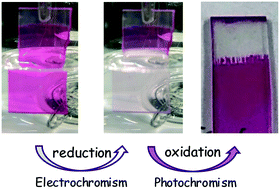Chemical bath deposition of transparent ZnO films incorporated with erythrosine B molecules and their synergetic electro/photochromic properties
Abstract
Erythrosine B (EB) dye molecules were embedded in a transparent ZnO semiconductor film, aiming at fabricating an organic/inorganic chromic material. A red-coloured, 3.4 μm thick ZnO film was obtained through a chemical bath deposition method conducted at a low temperature of 90 °C. The EB dye was confirmed to be distributed uniformly inside the ZnO film. Spectroelectrochemical measurement was performed using a three-electrode system with the EB/ZnO film employed as the working electrode. The red colour of the film started to disappear at an applied potential of −0.9 V in a negative scan of cyclic voltammetry. The decolourized film slowly became coloured again at +1.9 V and above in a positive scan. The electrochemically decolourized film was also coloured under fluorescent lighting without applying the potential. Because the EB dye dissolved in water did not show such a reversible colour change, the observed electro/photochromism is attributed to the EB/ZnO hybrid structure where the organic molecules are electronically functionalized by the metal oxide semiconductor.



 Please wait while we load your content...
Please wait while we load your content...